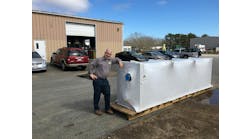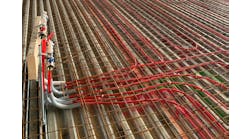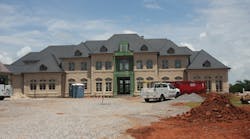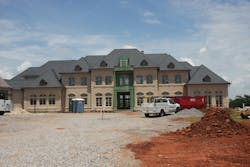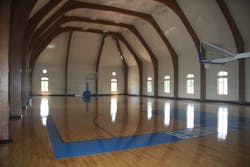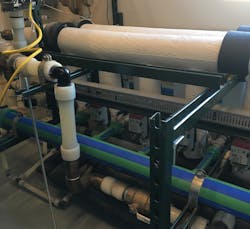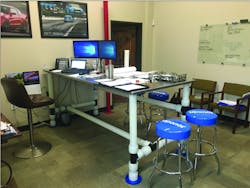OKLAHOMA CITY — Randy Hunter, the owner and founder of Hunter Mechanical & Controls has been in business since 1986. For the first five years, he was a one-man show.
“We grew very slowly over a period of time,” Hunter explained, “I think we have about 50 employees now.”
Hunter Mechanical does most of its work in the Oklahoma City metro area, but will take jobs that are almost a two-hour drive away. The company is known for its commercial work, and for specializing in geothermal. They will take the occasional residential job, however, “I’m not interested in doing a house unless it’s geothermal, and people really want a nice system,” Hunter said.
Hunter’s interest in geothermal technology began on a job where he was working on the mechanical side of another contractor’s geothermal work. He began researching the technology, investing in tools, and eventually talked a friend who was building a new house into letting him install a geothermal system. And then he talked another friend into it.
Soon he was bidding geothermal jobs for a round of new schools in the Oklahoma City area. “I bought all the tools and started doing all these schools,” Hunter said, “and I’m telling you, some of these were multi-million dollar mechanical jobs and sometimes I was the only bidder.”
The single-family dream-home Hunter Mechanical & Controls completed in November of 2015 was just up their alley: a residential job on a commercial scale. The house is 20,000-sq.ft., with a separate 10,000-sq.ft. building that includes an indoor basketball court and gym.
“I’ve got a long relationship with the builder who built it,” Hunter said. “They determined right off the bat that they wanted geothermal. We had just built our new [office] building that has [radiant] heated and cooled floors. They came over here and were able to look at it, see all the pieces and parts and how it works. Really, our building is what sold the job.”
Hunter calls the combination of radiant and geothermal a “marriage made in heaven,” since almost all the thermal energy is exchanged between various liquid media.
The system itself begins with the geothermal field of 18, 400-ft. wells just in front of the main house laid out in a horseshoe configuration. Hunter Mechanical & Controls has a long-standing relationship with a drilling firm. “I’ve never owned a drilling rig,” Hunter said, “but we did all the headering out in the well field ourselves, and did all the piping and mechanical in the building.”
The north end of the gym has a central plant with two five-ton and two ten-ton water-to-water geothermal units from ClimateMaster (30 tons altogether). When each of the seven separate zones is in need of hot or cold water, the three-way valves select the heating or cooling manifold (depending on the need). Each zone works independently.
“[The owners] can heat and cool simultaneously if they want to,” Hunter said, “and they do, sometimes... they’ll get a solar load sometimes with the south winter sky where they need to do a bit of cooling up there when they’re heating the rest of the house.”
Hunter Mechanical & Controls did five home runs from the central plant to each of the five mechanical rooms in the house, and a sixth to the pool, using Ecoflex pipe from Uponor. “That [pipe] was awesome,” Hunter said. “It’s already insulated in a protective sleeve… By using Ecoflex we needed less trenching and fewer connections than we would have needed with a rigid system.”
In the course of the installation, the company installed something in the neighborhood of 22,000 ft. of Uponor’s ½” PEX (for the potable water) and hePEX (for the hydronic systems) tubing.
To get the most out of every therm, insulation was a high priortity. The gym is manufactured almost entirely out of SIP — Structurally Insulated Panels — even the roof.
“[SIP] are 24-ft. long panels that come from Canada,” Hunter explained. “They come sandwiched with foam inside them. The gym was finished a couple of years before the rest of the home so the kids could use it… I could cool that gym with just 3 tons… that’s 10,000-sq.ft. on a 100-degree Fahrenheit Oklahoma day. That’s some major insulation.” Much of the cooling in the gym is done via hydronic air handling units.
The house is all 2 X 6 construction and spray-foamed. Even the attic is part of the conditioned space. “I’ll tell you how tight an envelope it is,” Hunter said. “I put an ERV [Energy Recovery Ventilator] on it hooked on the exhaust side to all the restrooms, constantly exhausting them 24-hours-a-day. You can’t hear it in the restrooms at all, it’s very quiet. The ERV is there in the attic dumping fresh air back into the house.”
Dampers in the attic pull return and supply air both into the attic. The result is a fully-conditioned attic space that is neither hot nor cold, will never condense during the wintertime, and is perfect for storage.
Grundfos variable speed circulators keep the heat transfer fluid moving efficiently through the system. And — as with any system of this size and complexity — there is a sophisticated controls package from Delta, just as you would have on a commercial building.
“I actually have a separate controls company,” Hunter said. “We put remote access on every system we put in, because when you do a job like this, you need to do a lot of tweaking. And that tweaking is done after people move in. That’s when you notice the little things that maybe need to be done differently.”
The entire installation, including the plumbing, took Hunter Mechanical more than a year, with a crew sometimes as large as six installers at one time. The family has been in residence almost a year and a half.
“They love the system,” Hunter said. “Actually, this last winter, one of the [hot water] pumps lost its program… it had been down for 36 hours and the [outside] temperature was really cold, below freezing and probably into the teens at night – but it took two days for them to notice!... The thermal mass of the slab is pretty remarkable. But they love it, absolutely.”
All the space you could need, efficiency and comfort — sounds like almost anyone’s idea of a dream home.
Hey Randy, what’s with the desk?
Randy Hunter is a big fan of PEX. In fact, he serves on Uponor’s Radiant Advisory Council helping advise the manufacturer and the industry on market trends related to radiant heating and cooling.
So naturally, he wanted a desk made out of PEX. “My son had made a desk out of Victaulic steel pipe,” Hunter said, “and I thought it would be really nice if I could build myself one out of PEX.”
Specifically, he wanted it made out of 3” PEX pipe. “They’ve had 3” PEX for a long time, but they didn’t have a good tool to put it together, an expansion tool, until Milwaukee came out with one,” Hunter said.
Hunter put it together in his spare time. It measures 4’ X 8’, and is the crowning jewel of his private office.
